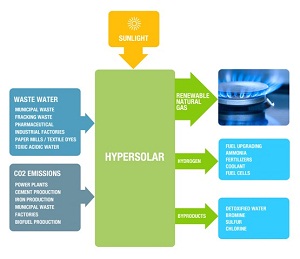Solar power gets gassy with HyperSolar’s photochemical natural gas technology
 Take wastewater, carbon dioxide and the sun and what do you get? not much more than you had to begin with—pollution.
Take wastewater, carbon dioxide and the sun and what do you get? not much more than you had to begin with—pollution.
But HyperSolar is developing a nanoparticle photosynthetic-based product that will produce natural gas from just those three things. The process will produce carbon-neutral methane, chemical byproducts that can be used in industrial processes and clean water, all from the sun. The company filed a patent Nov. 15 for the production of renewable natural gas using its nanoparticle, photoelectric process.
The device the company is developing would produce methane that’s a direct replacement for traditional natural gas, without drilling or fracking, according to the company. Since it will ideally rely on existing carbon dioxide sources, it will help mitigate CO2 emissions, rather than introduce new CO2 into the atmosphere as burning fossil fuels do.
“The actual processes our nanoparticles facilitate are photoelectrochemical reactions in which we turn solar energy into chemical energy,” Young said. “Our nanoparticles are self-contained solar-powered systems. Just like plant leaves lying under the sun, billions of our nanoparticles can float in low-cost transparent wastewater vessels all independently bubbling up hydrogen and other valuable chemicals. If one nanoparticle fails, there are many more that will continue working. To increase the scale of this system, we simply add more vessels and more nanoparticles.”
What’s different about the process is that unlike traditional electrolysis, which needs high voltages and produces both oxygen and hydrogen, this process only produces hydrogen, water and usable byproducts.
“We produce hydrogen without using any natural gas,” Young said.
The company is developing the device to produce methane that’s competitive with future natural gas prices, according to Young.
“But it's important to understand that we drive our cost of production down by solving someone's wastewater issue, [like] large paper or pulp mills, for example,” he said. “The best location would ideally be where we can solve a wastewater issue as well as a C02 or carbon emissions issue.”
The company is still developing the device, but it’s also designed to be tuned to various wastewater needs by changing the solar absorber’s composition. That way, depending on where it’s located, it can produce different byproducts, like chlorine or bromine.



